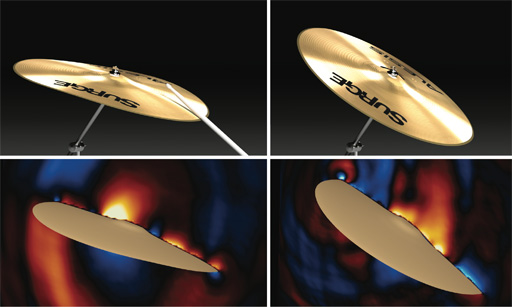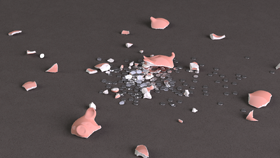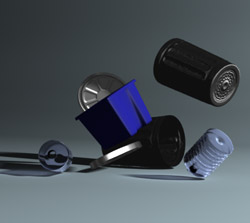
- Webpage
- Due in one week.
TuApr06

References:
- Slides (PDF)
- M. S. Howe. (2002). Theory of Vortex Sound. [Online]. Cambridge Texts in Applied Mathematics. (No. 33). Cambridge: Cambridge University Press. Available from: Cambridge Books Online <http://dx.doi.org/10.1017/CBO9780511755491>
- Chapter 1, Introduction.
- Bridson, R., Fedkiw, R., and Muller-Fischer, M. 2006. Fluid simulation: SIGGRAPH 2006 course notes, In ACM SIGGRAPH 2006 Courses (Boston, Massachusetts, July 30 - August 03, 2006). SIGGRAPH '06. ACM Press, New York, NY, 1-87. [Slides, Notes]
- See "Appendix A Background" (of the Notes) for a good primer on vector calculus for fluids.
TuApr13
![From [Chadwick et al., SIGGRAPH 2012]](http://www.cs.cornell.edu/%7Edjames/research/pics/thumb_fasterPAN_SCA2012.jpg)
References:
- Slides (PDF1, PDF2 (updated))
-
Jeffrey
N. Chadwick, Changxi
Zheng and Doug
L. James, Precomputed Acceleration
Noise for Improved Rigid-Body Sound, ACM Transactions on Graphics, August 2012. (PDF - Table 1 typo
fixed)
- Jeffrey N. Chadwick, Changxi Zheng, and Doug L. James, Faster Acceleration Noise for Multibody Animations using Precomputed Soundbanks, ACM/Eurographics Symposium on Computer Animation, July 2012.
TuApr20
Real-time Rigid-Body Dynamics
with Acceleration Noise
- Due in 3 weeks.
- Some tips for real-time audiovisual simulation (PDF)

& sound synthesis

Slides: PDF, key, Notes(PDF)
References:
- A.A. Shabana. Theory of Vibration, Volume II: Discrete and Continuous Systems. Springer-Verlag, New York, NY, first edition, 1990. [Excellent reference on modal vibration analysis fundamentals]
- K. van den Doel and D. K. Pai, The
Sounds of Physical Shapes, Presence:
Teleoperators and Virtual Environments, 7:4, The MIT
Press, 1998. pp. 382--395.
- Kees van den Doel, Paul G. Kry, Dinesh K. Pai, FoleyAutomatic:
Physically-Based Sound Effects for Interactive
Simulation and Animation, Proceedings of ACM
SIGGRAPH 2001, Computer Graphics Proceedings, Annual
Conference Series, August 2001, pp. 537-544. [Video]
- Dinesh K. Pai, Kees van den Doel, Doug L. James, Jochen Lang, John E. Lloyd, Joshua L. Richmond, Som H. Yau, Scanning Physical Interaction Behavior of 3D Objects, Proceedings of ACM SIGGRAPH 2001, Computer Graphics Proceedings, Annual Conference Series, August 2001, pp. 87-96. [Video]
- Doug L. James and Dinesh K. Pai, DyRT: Dynamic Response Textures for Real Time Deformation Simulation with Graphics Hardware, ACM Transactions on Graphics (ACM SIGGRAPH 2002), 21(3), pp. 582-585, 2002.
- James F. O'Brien, Chen Shen, and Christine M.
Gatchalian. Synthesizing
sounds from rigid-body simulations. In The
ACM SIGGRAPH 2002 Symposium on Computer Animation, pages
175–181. ACM Press, July 2002.
- Changxi Zheng and Doug L. James, Rigid-Body
Fracture Sound with Precomputed Soundbanks,
ACM Transactions on Graphics (SIGGRAPH 2010), 29(3),
July 2010, pp. 69:1-69:13 (see appendix on
modal sound synthesis)
- Changxi Zheng and Doug L. James, Toward
High-Quality Modal Contact Sound, ACM
Transactions on Graphics (SIGGRAPH 2011), 30(4), August
2011.
- Timothy R. Langlois, Steven S. An, Kelvin K. Jin, and Doug L. James. Eigenmode Compression for Modal Sound Models. ACM Transactions on Graphics (SIGGRAPH 2014). 33(4), August, 2014.
![[Chadwick and James 2011]](http://www.cs.cornell.edu/%7Edjames/research/pics/thumb_fireDragon.jpg)
Reference:
- Jeffrey Chadwick and Doug L. James, Animating Fire with Sound, ACM Transactions on Graphics, 30(4), August 2011.
ThApr29
![[Zheng and James 2009]](http://www.cs.cornell.edu/%7Edjames/research/pics/thumb_harmonicFluids.jpg)
- Changxi Zheng and Doug L. James, Harmonic Fluids, ACM Transaction on Graphics, 28(3), July 2009, pp. 37:1-37:12.
- Timothy R. Langlois, Changxi Zheng, and Doug L. James, Toward Animating Water with Complex Acoustic Bubbles, ACM Transactions on Graphics (SIGGRAPH 2016).
ThMay06
TuMay11
ThMay13

References:
- Yoshinori Dobashi, Tsuyoshi Yamamoto, Tomoyuki Nishita, Real-Time Rendering of Aerodynamic Sound Using Sound Textures Based on Computational Fluid Dynamics, ACM Transactions on Graphics, 22(3), July 2003, pp. 732-740. [project page]
- M. S. Howe. (2002). Theory of Vortex Sound. [Online]. Cambridge Texts in Applied Mathematics. (No. 33). Cambridge: Cambridge University Press. Available from: Cambridge Books Online <http://dx.doi.org/10.1017/CBO9780511755491>
- Y. Dobashi, T. Yamamoto, T. Nishita, Synthesizing Sound from Turbulent Field using Sound Textures for Interactive Fluid Simulation, Computer Graphics Forum (Proc. EUROGRAPHICS 2004), Vol. 23, No. 3, pp. 539-546, 2004. [project page]
ThMay20
ThMay20

- Jui-Hsien Wang, Physics-based Sound Synthesis Using Time-domain Methods, Stanford Ph.D. dissertation, 2019.
- Jui-Hsien Wang, Ante Qu, Timothy R. Langlois, and Doug L. James. 2018. Toward Wave-based Sound Synthesis for Computer Animation. ACM Trans. Graph. 37, 4, Article 109 (August 2018), 16 pages.
- Andrew Allen and Nikunj Raghuvanshi. 2015. Aerophones in Flatland: Interactive wave simulation of wind instruments. ACM Trans. Graph. 34, 4, Article 134 (August 2015), 11 pages. [ACM] [Paper] [Video] [Presentation] [SIGGRAPH trailer]
and Animation Control
- Timothy R. Langlois and Doug L. James. Inverse-Foley Animation: Synchronizing rigid-body motions to sound, ACM Transactions on Graphics (SIGGRAPH 2014). 33(4), August, 2014.
- Popovic, J., Seitz, S., Erdmann, M., Popovic, Z., and Witkin, A. 2000. Interactive manipulation of rigid body simulations. In Proceedings of ACM SIGGRAPH 2000, ACM Press/Addison-Wesley Publishing Co., 209–218.
- Chenney, S., and Forsyth, D. A. 2000. Sampling plausible solutions to multi-body constraint problems. In Proceedings of ACM SIGGRAPH 2000, ACM Press/Addison-Wesley Publishing Co., 219–228.
- Christopher D. Twigg and Doug L. James. Many-worlds browsing for control of multibody dynamics. ACM Transactions on Graphics (SIGGRAPH 2007), 26(3), August 2007.

- Eston Schweickart, Doug L. James, and Steve Marschner, Animating Elastic Rods with Sound, ACM Transactions on Graphics (SIGGRAPH 2017). 36(4), Article 115. July 2017.
TuJun01

- Jeffrey N. Chadwick, Steven S. An, and Doug L. James, Harmonic Shells: A Practical Nonlinear Sound Model for Near-Rigid Thin Shells, ACM Transactions on Graphics (SIGGRAPH ASIA Conference Proceedings), December 2009

- Changxi Zheng and Doug L. James, Rigid-Body Fracture Sound with Precomputed Soundbanks, ACM Transaction on Graphics (SIGGRAPH 2010), 29(3), July 2009.


![Precomputed
Acoustic Transfer [James et al. 2006]](pics/PAT.gif)
![Stable Fluids
[Stam 1999]](http://www.cs.cornell.edu/courses/cs567/2007sp/images/thumb_stableFluids.png)
